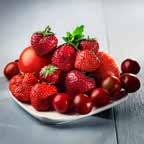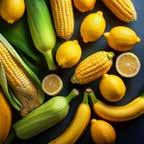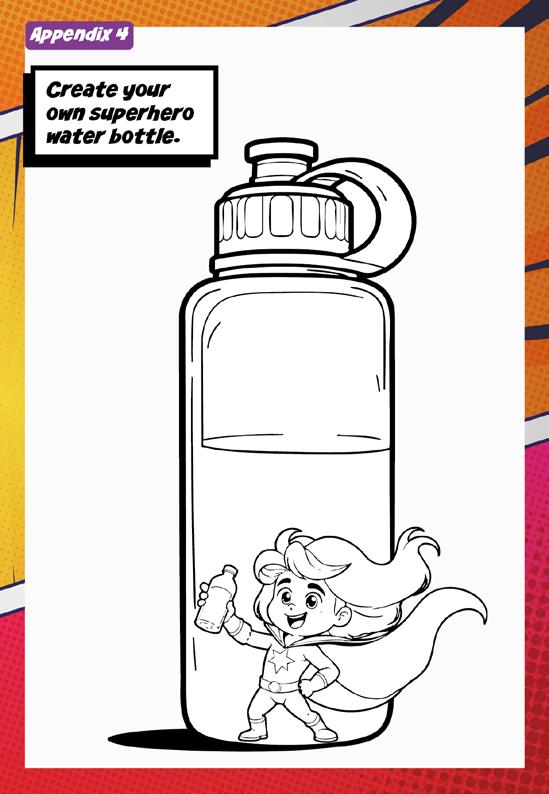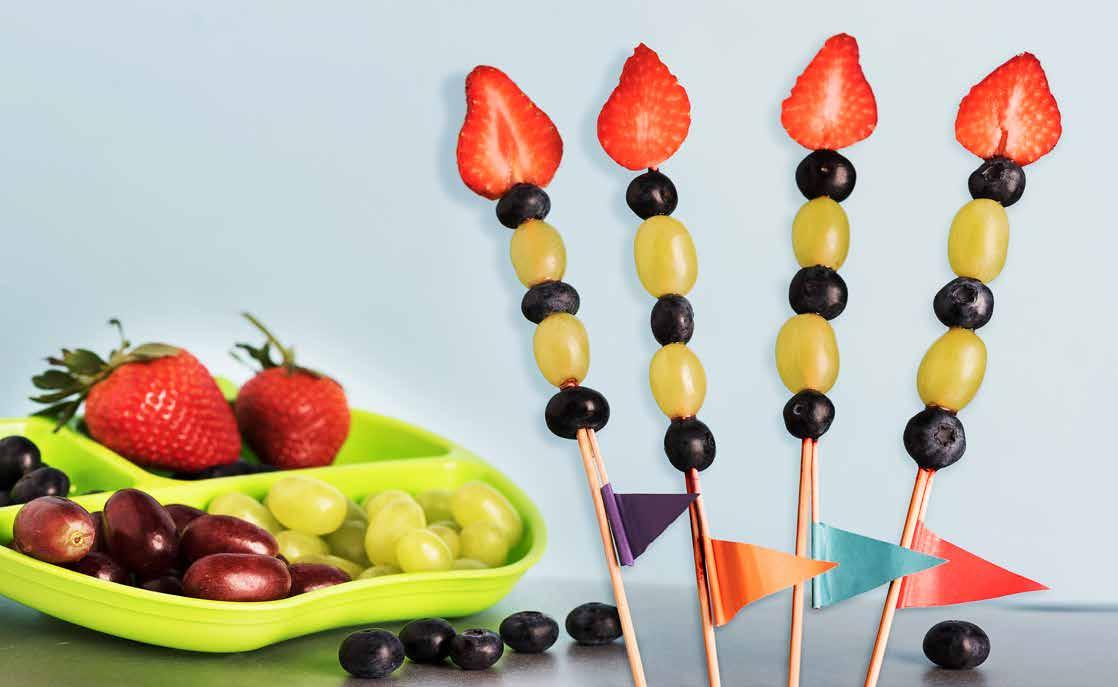
























With thanks to NHSCT Public Health Dietitians for reviewing this resource.
This toolkit offers an engaging method of influencing children to eat fruit and vegetables, think about their sugar intake and keep hydrated. You can use this toolkit in a variety of ways in your setting including using the resources at the back of the booklet, however, feel free to modify the programme to fit the needs and schedule of your group!
Sentences written in GREEN – questions / information speak aloud to participants.
Sentences written in RED – answers to questions.
Sentences written in BLUE – activities.
It is important to ensure that you are aware of each child’s allergies.
For a list of common allergens please see Appendix 1.
We as a Council accept no responsibility should an injury or illness occur as a result of participating in a “Healthy Heroes” programme. It is each organisation’s responsibility to ensure safety in respect of preparation and consumption of food.

It is important that participants learn how to prepare food hygienically and safely.
• Ensure hands are washed thoroughly prior to food preparation. (Please see Appendix 2 for Hand Washing Guidance).
• Ensure food preparation benches or tables are disinfected prior to use.
• Ensure sinks are washed and disinfected before and between uses.
• Ensure fruit and vegetables are washed prior to preparation. (Please note unwashed fruit and vegetables are classified as raw foods).
• Where possible, tie hair up.
• Ensure any cuts or sores on hands and arms are covered with bright coloured waterproof plasters.
• Participants should not sample ingredients during the preparation stage.
• Children or leaders that have suffered from any vomiting/ diarrhoea 48 hours prior should not be included in the preparation.
• If you are prepping the food with the children, a responsible adult should demonstrate how to complete each task i.e. using knives, using scales etc.
• Children should never be left unattended.
• Food should be cut into smaller sized pieces to avoid becoming a choking hazard.
• It is recommended that children under 5 years of age do not consume whole nuts.
• There should be no running with knives/scissors.
• Spillages onto floors should be cleaned promptly to minimise the risk of slips and falls.
• Read labels of any cleaning chemical in use and follow manufacturing instructions.


A Children will participate in a standard hand washing activity.
A Children will understand when they need to wash their hands.
When should we wash our hands?
After we touch animals, after we play outside, after we go to the toilet, during and after we are cooking/baking.
Why should we wash our hands?
To stop germs spreading and causing illnesses such as food poisoning.
Set the hand washing machine in a proper place where all groups can access.
A Hand washing kit (UV gel and hand washing machine) – you can borrow this from your local Environmental Health Department. A Extension cable if necessary.

1. Depending on time, ask for a few volunteers to participate in the demonstration.
2. Ask volunteers to come forward and put the UV gel on their unwashed hands and rub hands together.
3. Tell the children to then place their hands under the UV light of the hand washing machine.
4. Ask the rest of the group to observe the volunteers’ hands. The germs should be highlighted in a white colour.
5. Demonstrate using the diagram in Appendix 2 the proper steps to wash hands and get the volunteers to then go and wash their hands.
6. Tell the children to put their hands back under the UV light after washing their hands. Any white spots indicate germs they have missed when washing.
7. Invite the rest of the group to observe the difference of the hands before and after.

A Participants can read nutrition information labels to work out how much sugar a drink or food contains.
A Students can identify some health problems related to excessive sugar consumption.
Explain to the participants that today they are going to become food detectives and find out all about sugar. Ask the participants what their maximum daily sugar limit is.
4-6 year olds: 19g = 5 sugar cubes.
7-10 year olds: 24g = 6 sugar cubes.
11+ year olds: 30g = 7 sugar cubes.
What foods contain sugar?
Sweets, fizzy drinks and juices.
How can we find out how much sugar they contain?
Traffic light labels are displayed on the front of food and drink packaging to help make healthier choices. Green means low in sugar (healthier choice), amber means medium (can enjoy most of the time but still be mindful), and red means high (limit intake to occasional treats and smaller portions).
Ask the pupils what will happen if they eat too much sugar.
Sugary foods can cause tooth decay, feeling tired, gaining weight, or getting sick. Sugary foods should be eaten as a treat and when hungry think of healthier options for snacks.
Download this app to find out more information about the content of the group’s favourite foods.


• Have 4 different snacks/ drinks laid out on each table.
• Provide a box of sugar cubes for the children to guess the amount of sugar cubes in food and place in front of the packet.
A 4 different snacks / drinks.
A Sugar cubes.
A Example food label.

1. Divide the participants into groups. Place the example sugary foods/ drinks randomly on the tables.
2. Explain that they need to place how many sugar cubes they think are in each item just below the image.
3. Once the participants are happy with their selection, reveal what the correct number of sugar cubes are in each snack. (Answers at bottom of page). Explain to them using an example of how they can find out the amount of sugar in the food by looking at the nutrition label.
4. Are they surprised? Ask the participants if they think they might change some of their food choices as a result of what they have discovered.
A Coca-Cola (330 ml) - 9.
A 1 tube of Rowntree’s Fruit Pastilles (48g) - 6.
A Cadbury Dairy Milk chocolate bar (45g) - 6.
A 1 Bottle of Lucozade (380ml) - 4.
A Can Fanta (330ml) - 4.
A Can Red Bull (250ml) - 7.
A 1 Milk Chocolate Digestive (17g) - 1.
A 1 Scoop Plain Ice-cream (60g) - 4.
A 1 Mars Bar (51g) - 8.
(Information correct at time of printing July 2025).

Give each pupil small samples of different fruit and vegetables that you have prepared. These can include raw veggies! E.g. mushrooms, carrots, peppers.
I TY
15 mins

A Participants will be aware of the benefits of eating a wide range of colours of fruit and vegetables.
Explain that fruit and vegetables are great because they are an important part of a healthy, balanced diet.
Explain to participants that certain fruit and vegetables have different ‘powers’ because of their vitamins and the nutrients they provide. Complete activity below then explain the answers.
(See information box on next page).
Encourage the children to eat a variety of fruit and vegetables a day and pick a different colour each time (5 portions a day, one portion is equal to the size of a child’s fist).
1. Divide the pupils into groups and place a laminated rainbow and sticky notes on the desk of each group.
2. Ask the children to write the name of the food item on the sticky note and place it on the corresponding colour of the rainbow.
3. Explain that the group with the most correctly placed sticky notes will win.
A Laminated rainbows. A Sticky notes. A Pens.
• Set out the laminated rainbows on each group’s table.
• Give each group a stack of sticky notes and pens.

After this activity is completed and you have checked the sticky notes, explain some benefits of the fruit/vegetables they have chosen e.g.

Fruit and vegetables are good for their heart and help them run and play faster.


Fruit and vegetables help their eyes see clearly and keep their skin healthy.

Fruit and vegetables help their bodies grow strong and keep them energised.


Fruit and vegetables help their bodies fight off sickness and keep them healthy.
Fruit and vegetables can protect their bodies from disease, help memory and promote healthy aging.
Fruit and vegetables protect cells from damage, boost brain function and mood.


A Participants will be able to identify the percentage of water in the human body.
A Understand the importance of keeping our bodies hydrated.
START A CONVERSATION AROUND DRINKING ENOUGH WATER
Ask if anybody knows how much water children are meant to drink a day.
6-8 glasses (150-200ml per glass depending on child).
Ask if anyone meets the recommended amount of water.
Ask if anybody knows what will happen if you do not drink enough water.
Thirst, dry mouth, lips and eyes, peeing less often, dark yellow pee, feeling tired.

Read aloud each of the statements below.
Ask the participants to raise their paddle with the thumbs up if they think it is a fact or raise their paddle with the thumbs down if they think it is fiction.
1. “Our body is mostly made of water.”
Fact (About 60–70%).
2. “Energy drinks give us energy for sport. ”
Fiction (Energy drinks are not suitable for under 16s as they contain caffeine and can have high levels of sugar).
3. “You only need to drink water if you’re thirsty.”
Fiction (Thirst means you’re already a little dehydrated).
4. “Drinking water helps you concentrate at school.”
Fact (The brain is mostly composed of water, so it is important it stays hydrated).
5. “Water can help stop you from getting headaches.”
Fact (If you’re not drinking enough water throughout the day, or if you’ve been sweating a lot due to heat or exercise, your body may signal this lack of hydration through a headache).
6. “Fizzy drinks are a healthy way to stay hydrated.”
Fiction (they often contain high amounts of sugar which can lead to dehydration).
7. “Fruits like watermelon and cucumber have water in them.”
Fact (watermelon contains around 92% water, while cucumber contains about 96% water).


A Children will develop their cooking skills.
A Children will be able to make smart snack choices and recognise their benefits.
What is your favourite snack?
Can you name healthy snacks?
Examples to give – carrot sticks, fruit with yoghurt, apple slices with peanut butter, grapes or berries, oatcakes with tomatoes and cheese.
1. Divide children into groups.
2. Ensure the children have washed their hands before starting to prepare the food.
3. Choose recipes you will be making from Appendix 5 and follow instructions.
A See Appendix 5 recipes for cooking equipment needed.
A Tables for participants to work at.
A Disinfectant to clean tables before use.

1. Pizza sliders.
2. Egg muffins.
3. Flower bouquet.
4. Fruit rocket.
Use By Dates and Best Before Dates.


A Understand the difference between Use By and Best Before dates.
A Recognise the importance of food labels.
Does anyone know the difference between a Use By date and a Best Before date?
Use By date: Food must be eaten before this date — after it’s unsafe.
Best Before date: Food is best quality until this date but might still be safe after.
Explain that Use By dates are for high-risk foods e.g. meat and poultry, seafood, dairy products and ready to eat foods.
Best Before dates are for low-risk foods – e.g. crisps, crackers, biscuits, flour, plain breads and rolls.
Discuss why these dates are important to follow.
Best Before and Use By dates on food labels are used to keep food safe and to help reduce food waste. Food may contain bacteria, and if stored for too long or at the wrong temperature can cause food poisoning.
1. Divide participants into groups.
2. Set ‘Best Before’ and ‘Use By’ date signs on each desk.
3. Place different foods on each table.
A Different food items (this can be a picture of the food, or the food written down on a piece of paper).
A ‘Use By date’ and ‘Best Before date’ signs for each table.
1. Place the laminated food items randomly on the table along with the ‘Use By date’ sign and the ‘Best Before date’ sign at each end.
2. Have the participants place each food item whether they think it is under the ‘Best Before’ sign or the ‘Use By’ sign.
3. When they have finished, walk around each group and discuss correct/ incorrect answers. Answers can be found in the red box.

Use By – chicken, steak, ready-made meal, fish, cheese, milk.
Best Before – crisps, biscuits, eggs, pasta, rice, baked beans, frozen chips, chocolate.

Print these out for your group!

There are 14 major allergens which need to be mentioned (either on a label or through provided information such as menus) when they are used as ingredients in a food. Here are the allergens, and some examples of where they can be found:

Celery 1
This includes celery stalks, leaves, seeds and the root called celeriac. You can find celery in celery salt, salads, some meat products, soups and stock cubes.

Crustaceans 3
Crabs, lobster, prawns and scampi are crustaceans. Shrimp paste, often used in Thai and south-east Asian curries or salads, is an ingredient to look out for.
Fish 5

You will find this in some fish sauces, pizzas, relishes, salad dressings, stock cubes and Worcestershire sauce.
Wheat (such as spelt and Khorasan wheat/Kamut), rye, barley and oats is often found in foods containing flour, such as some types of baking powder, batter, breadcrumbs, bread, cakes, couscous, meat products, pasta, pastry, sauces, soups and fried foods which are dusted with flour.
2


Lupin 6
4
Eggs are often found in cakes, some meat products, mayonnaise, mousses, pasta, quiche, sauces and pastries or foods brushed or glazed with egg.

Yes, lupin is a flower, but it’s also found in flour! Lupin flour and seeds can be used in some types of bread, pastries and even in pasta.
Milk is a common ingredient in butter, cheese, cream, milk powders and yoghurt. It can also be found in foods brushed or glazed with milk, and in powdered soups and sauces.


Liquid mustard, mustard powder and mustard seeds fall into this category. This ingredient can also be found in breads, curries, marinades, meat products, salad dressings, sauces and soups.

These seeds can often be found in bread (sprinkled on hamburger buns for example), breadsticks, houmous, sesame oil and tahini. They are sometimes toasted and used in salads.

These include mussels, land snails, squid and whelks, but can also be commonly found in oyster sauce or as an ingredient in fish stews.


Not to be mistaken with peanuts (which are actually a legume and grow underground), this ingredient refers to nuts which grow on trees, like cashew nuts, almonds and hazelnuts. You can find nuts in breads, biscuits, crackers, desserts, nut powders (often used in Asian curries), stir-fried dishes, ice cream, marzipan (almond paste), nut oils and sauces.
Often found in bean curd, edamame beans, miso paste, textured soya protein, soya flour or tofu, soya is a staple ingredient in oriental food. It can also be found in desserts, ice cream, meat products, sauces and vegetarian products.

Peanuts are actually a legume and grow underground, which is why it’s sometimes called a groundnut.
Peanuts are often used as an ingredient in biscuits, cakes, curries, desserts, sauces (such as satay sauce), as well as in groundnut oil and peanut flour.

This is an ingredient often used in dried fruit such as raisins, dried apricots and prunes. You might also find it in meat products, soft drinks, vegetables as well as in wine and beer. If you have asthma, you have a higher risk of developing a reaction to sulphur dioxide.





Ingredients 1 x soda farl or baguette
2 x tablespoons of tomato puree
small tin of sweetcorn
½ x pepper

Equipment 1 x air fryer
1 x chopping board
1 x knife
1 x tablespoon
1 x bread knife
Method 1. Cut the soda farl/baguette in half lengthways. Then cut each of those pieces in half again, width ways.
2. Spread tomato puree over each of the soda farls/baguette.
3. Drain sweetcorn.
4. Wash, deseed and cut pepper into small chunks and place on top of the soda farls/baguette along with the sweetcorn.
5. Place in air fryer and cook at 200°C for 5-6 minutes (adult task).
Top Tips • Grated cheese and cooked chicken/ham can also be added to the pizza.
• Be careful of salt content. A corn or wholemeal tortilla wrap could be used as a substitute to soda farls/baguette.


Ingredients

Method
5 x medium eggs
½ x red pepper
small tin of sweetcorn
6 cherry tomatoes
Equipment 1 x air fryer
1 x mixing bowl
1 x jug
1 x chopping board
1 x knife
1 x spoon
1 x wooden spoon
6 x silicone bun cases
Top Tips
1. Wash, deseed and cut pepper into small squares.
2. Cut tomatoes in half.
3. Drain sweetcorn.
4. Place pepper and sweetcorn into mixing bowl.
5. Crack 5 eggs into the mixture (adult task). Allow each child the opportunity to mix the mixture.
6. Place one tomato into each of the silicone bun cases.
7. Transfer mixture from mixing bowl into jug.
8. Pour mixture from jug into bun cases. Allow each child to pour the mixture for their own muffin.
9. Place 6 bun cases at a time into the air fryer and cook at 190°C for 7-8 minutes(adult task).
10. Ensure the muffins are thoroughly cooked before serving.
• A variety of vegetables can be used to make this recipe.
• Cooked ham cut into squares can also be used where there are no vegetarian children.

Ingredients 10 x blueberries
2 x apples
2 x kiwis
5 x strawberries

Equipment 1 x assorted flower cookie cutter
5 x blunt wooden skewers
1 x chopping board
1 x apple corer
Method 1. Wash blueberries, apples and strawberries.
2. Cut kiwi into 1cm slices.
3. Core apple and cut into slices 1 cm thick (adult task).
4. Cut various sizes of flowers from the fruit using cookie cutters.
5. Assemble the fruit to make a flower bouquet.
Top Tips • A variety of different fruit can be used for this recipe so why not get creative?


Ingredients 12 x blueberries
8 x grapes
2 x strawberries

Equipment 1 x knife (per child)
4 x blunt wooden skewers
1 x chopping board
Method 1. Wash blueberries, grapes and strawberries.
2. Cut strawberries in half.
3. Assemble rocket by placing 2 grapes and 3 blueberries onto skewers and topping with half a strawberry.
Top Tips • Think of other fruit you could use to build your rocket.











Date published July 2025
